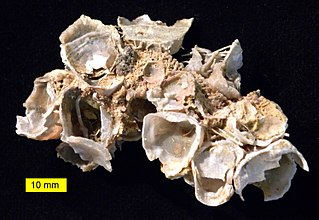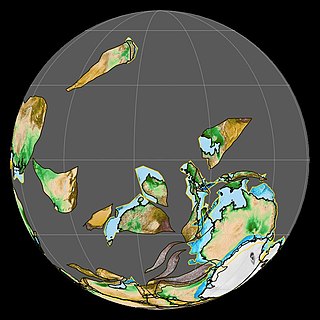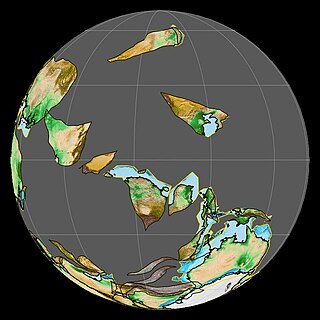Related Research Articles

The Carboniferous is a geologic period and system of the Paleozoic that spans 60 million years from the end of the Devonian Period 358.9 million years ago (Mya), to the beginning of the Permian Period, 298.9 million years ago. The name Carboniferous means "coal-bearing", from the Latin carbō ("coal") and ferō, and refers to the many coal beds formed globally during that time.
The Mississippian is a subperiod in the geologic timescale or a subsystem of the geologic record. It is the earlier of two subperiods of the Carboniferous period lasting from roughly 358.9 to 323.2 million years ago. As with most other geochronologic units, the rock beds that define the Mississippian are well identified, but the exact start and end dates are uncertain by a few million years. The Mississippian is so named because rocks with this age are exposed in the Mississippi Valley.
The Pennsylvanian is, in the ICS geologic timescale, the younger of two subperiods of the Carboniferous Period. It lasted from roughly 323.2 million years ago to 298.9 million years ago. As with most other geochronologic units, the rock beds that define the Pennsylvanian are well identified, but the exact date of the start and end are uncertain by a few hundred thousand years. The Pennsylvanian is named after the U.S. state of Pennsylvania, where the coal-producing beds of this age are widespread.
In the geologic timescale, the Asselian is the earliest geochronologic age or lowermost chronostratigraphic stage of the Permian. It is a subdivision of the Cisuralian Epoch or Series. The Asselian lasted between 298.9 and 293.52 million years ago (Ma). It was preceded by the Gzhelian and followed by the Sakmarian.
In the geologic timescale, the Capitanian is an age or stage of the Permian. It is also the uppermost or latest of three subdivisions of the Guadalupian Epoch or Series. The Capitanian lasted between 264.28 and 259.51 million years ago. It was preceded by the Wordian and followed by the Wuchiapingian.
In the geologic timescale, the Kungurian is an age or stage of the Permian. It is the latest or upper of four subdivisions of the Cisuralian Epoch or Series. The Kungurian lasted between 283.5 and 273.01 million years ago (Ma). It was preceded by the Artinskian and followed by the Roadian. It corresponds roughly to the Leonardian Stage, covering the span from 280 to 270.6 ± 0.7 Ma in the North American system.

In the geologic timescale, the Roadian is an age or stage of the Permian. It is the earliest or lower of three subdivisions of the Guadalupian Epoch or Series. The Roadian lasted between 273.01 and 266.9 million years ago (Ma). It was preceded by the Kungurian and followed by the Wordian.
In the geologic timescale, the Wordian is an age or stage of the Permian. It is the middle of three subdivisions of the Guadalupian Epoch or Series. The Wordian lasted between 266.9 and 264.28 million years ago (Ma). It was preceded by the Roadian and followed by the Capitanian.
The Famennian is the latter of two faunal stages in the Late Devonian Epoch. The most recent estimate for its duration estimates that it lasted from around 371.1 million years ago to 359.3 million years ago. An earlier 2012 estimate, still used by the International Commission on Stratigraphy, estimated that it lasted from 372.2 million years ago to 358.9 million years ago. It was preceded by the Frasnian stage and followed by the Tournaisian stage.

The Tournaisian is in the ICS geologic timescale the lowest stage or oldest age of the Mississippian, the oldest subsystem of the Carboniferous. The Tournaisian age lasted from 358.9 Ma to 346.7 Ma. It is preceded by the Famennian and is followed by the Viséan. In global stratigraphy, the Tournaisian contains two substages: the Hastarian and Ivorian. These two substages were originally designated as European regional stages.

The Visean, Viséan or Visian is an age in the ICS geologic timescale or a stage in the stratigraphic column. It is the second stage of the Mississippian, the lower subsystem of the Carboniferous. The Visean lasted from 346.7 to 330.9 Ma. It follows the Tournaisian age/stage and is followed by the Serpukhovian age/stage.

The Serpukhovian is in the ICS geologic timescale the uppermost stage or youngest age of the Mississippian, the lower subsystem of the Carboniferous. The Serpukhovian age lasted from 330.9 Ma to 323.2 Ma. It is preceded by the Visean and is followed by the Bashkirian. The Serpukhovian correlates with the lower part of the Namurian Stage of European stratigraphy and the middle and upper parts of the Chesterian Stage of North American stratigraphy.
The Kasimovian is a geochronologic age or chronostratigraphic stage in the ICS geologic timescale. It is the third stage in the Pennsylvanian, lasting from 307 to 303.7 Ma. The Kasimovian Stage follows the Moscovian and is followed by the Gzhelian. The Kasimovian saw an extinction event which occurred around 305 mya, referred to as the Carboniferous Rainforest Collapse. It roughly corresponds to the Missourian in North American geochronology and the Stephanian in western European geochronology.

The Gzhelian is an age in the ICS geologic timescale or a stage in the stratigraphic column. It is the youngest stage of the Pennsylvanian, the youngest subsystem of the Carboniferous. The Gzhelian lasted from 303.7 to 298.9 Ma. It follows the Kasimovian age/stage and is followed by the Asselian age/stage, the oldest subdivision of the Permian system.
The Moscovian is in the ICS geologic timescale a stage or age in the Pennsylvanian, the youngest subsystem of the Carboniferous. The Moscovian age lasted from 315.2 to 307 Ma, is preceded by the Bashkirian and is followed by the Kasimovian. The Moscovian overlaps with the European regional Westphalian stage and the North American Atokan and Desmoinesian stages.
The Westphalian is a stage in the regional stratigraphy of northwest Europe with an age between roughly 313 and 304 Ma. It is a subdivision of the Carboniferous system or period and the regional Silesian series. The Westphalian is named for the region of Westphalia in western Germany where strata of this age occur. The Coal Measures of England and Wales are also largely of Westphalian age though they also extend into the succeeding Stephanian.
Conodonts are an extinct class of animals whose feeding apparatuses called teeth or elements are common microfossils found in strata dating from the Stage 10 of the Furongian, the fourth and final series of the Cambrian, to the Rhaetian stage of the Late Triassic. These elements can be used alternatively to or in correlation with other types of fossils in the subfield of the stratigraphy named biostratigraphy.
Neognathodus is an extinct genus of conodonts.
Declinognathodus is an extinct genus of platform conodonts.
Idiognathoides is an extinct genus of conodonts.
References
- ↑ "Chart/Time Scale". www.stratigraphy.org. International Commission on Stratigraphy.
- ↑ Lane, H.; Brenckle, Paul; Baesemann, J.; Richards, Barry (December 1999). "The IUGS boundary in the middle of the Carboniferous: Arrow Canyon, Nevada, USA". Episodes. 22 (4): 272–283. doi: 10.18814/epiiugs/1999/v22i4/003 .
- ↑ Gradstein, F.M.; Ogg, J.G. & Smith, A.G.; 2004: A Geologic Time Scale 2004, Cambridge University Press.
- ↑ Heckel, P.H. & Clayton, G.; 2006: The Carboniferous system, use of the new official names for the subsystems, series and stages, Geologica Acta 4(3), pp 403–407.
- ↑ Nemyrovska, T.I.; 1999: Bashkirian conodonts of the Donets Basin, Ukraine. Scr. Geol. 119, pp 1–115 (in Russian).
- ↑ Solovieva, M.N.; 1986: Zonal fusulinid scale of the Moscovian Stage based on a revision of the type sections of intrastage subdivisions, Vopr. Mikropaleontol. 28, pp 3–23 (in Russian).
- ↑ Lane, H.R.; Brenckle, P.L.; Baesemann, J.F. & Richards, B.; 1999: The IUGS boundary in the middle of the Carboniferous: Arrow Canyon, Nevada, USA, Episodes 22(4), pp 272–283.
Literature
- Menning, M.; Alekseev, A.S.; Chuvashov, B.I.; Davydov, V.I.; Devuyst, F.-X.; Forke, H.C.; Grunt, T.A.; Hance, L.; Heckel, P.H.; Izokh, N.G.; Jin, Y.-G.; Jones, P.J.; Kotlyar, G.V.; Kozur, H.W.; Nemyrovska, T.I.; Schneider, J.W.; Wang, X.-D.; Weddige, K.; Weyer, D. & Work, D.M.; 2006: Global time scale and regional stratigraphic reference scales of Central and West Europe, East Europe, Tethys, South China, and North America as used in the Devonian–Carboniferous–Permian Correlation Chart 2003 (DCP 2003), Palaeogeography, Palaeoclimatology, Palaeoecology 240(1-2): pp 318–372.